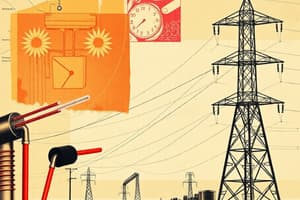Podcast
Questions and Answers
What happens to the capacitance of a transmission line when the spacing between the phases increases?
What happens to the capacitance of a transmission line when the spacing between the phases increases?
- Capacitance increases
- Capacitance remains the same
- Capacitance becomes zero
- Capacitance decreases (correct)
The radius of the conductors in a transmission line has no effect on the capacitance of the line.
The radius of the conductors in a transmission line has no effect on the capacitance of the line.
False (B)
What is the formula for capacitive reactance?
What is the formula for capacitive reactance?
ZC = -j/(2πfC)
The shunt capacitive admittance of a transmission line is given by the formula ____ × j 2π f.
The shunt capacitive admittance of a transmission line is given by the formula ____ × j 2π f.
Match the following concepts with their corresponding descriptions:
Match the following concepts with their corresponding descriptions:
What is the inductance of the line for a single-phase Partridge conductor with 20 ft spacing?
What is the inductance of the line for a single-phase Partridge conductor with 20 ft spacing?
The spacing factor for a 20 ft spacing is higher than the inductive reactance at 1 ft spacing.
The spacing factor for a 20 ft spacing is higher than the inductive reactance at 1 ft spacing.
What is the GMR for a Partridge conductor?
What is the GMR for a Partridge conductor?
The capacitive reactance for one mile of a single-phase line is measured in ______.
The capacitive reactance for one mile of a single-phase line is measured in ______.
Which conductor type is used in the example for both single-phase and three-phase lines?
Which conductor type is used in the example for both single-phase and three-phase lines?
Inductive reactance increases with the spacing between conductors.
Inductive reactance increases with the spacing between conductors.
How is the total inductive reactance for a 175-mile three-phase line calculated?
How is the total inductive reactance for a 175-mile three-phase line calculated?
Match the following properties to their corresponding values for the Partridge conductor:
Match the following properties to their corresponding values for the Partridge conductor:
What is the series impedance per kilometer of the transmission line?
What is the series impedance per kilometer of the transmission line?
The inductive reactance Xd is defined as the inductive reactance at a certain spacing.
The inductive reactance Xd is defined as the inductive reactance at a certain spacing.
What does GMR represent in transmission line calculations?
What does GMR represent in transmission line calculations?
The formula for capacitive reactance, given the values from the table, includes a factor of 2πf and a term for _______.
The formula for capacitive reactance, given the values from the table, includes a factor of 2πf and a term for _______.
Match the reactance calculation with their corresponding parameters:
Match the reactance calculation with their corresponding parameters:
What is the value of the inductive reactance Xa for a single-phase line at 60 Hz with 1 ft spacing?
What is the value of the inductive reactance Xa for a single-phase line at 60 Hz with 1 ft spacing?
In the context of transmission lines, what does a larger spacing between conductors typically lead to?
In the context of transmission lines, what does a larger spacing between conductors typically lead to?
If both GMR and GMD are in feet, Xa represents the inductive reactance at 6 ft spacing.
If both GMR and GMD are in feet, Xa represents the inductive reactance at 6 ft spacing.
Flashcards
Transmission Line Capacitance
Transmission Line Capacitance
The ability of a transmission line to store electrical energy in an electric field between its conductors.
Transmission Line Conductor Radius
Transmission Line Conductor Radius
The distance from the center of a conductor in a transmission line to its outer edge.
Shunt Capacitive Admittance
Shunt Capacitive Admittance
The ability of a transmission line to conduct current due to its capacitance, dependent on frequency.
Shunt Admittance per unit length
Shunt Admittance per unit length
Signup and view all the flashcards
Total Shunt Capacitive Admittance
Total Shunt Capacitive Admittance
Signup and view all the flashcards
Capacitive Reactance
Capacitive Reactance
Signup and view all the flashcards
Transmission Line Parameters
Transmission Line Parameters
Signup and view all the flashcards
Spacing between conductors
Spacing between conductors
Signup and view all the flashcards
Inductive Reactance
Inductive Reactance
Signup and view all the flashcards
Capacitive Reactance
Capacitive Reactance
Signup and view all the flashcards
Single-Phase Line
Single-Phase Line
Signup and view all the flashcards
Three-Phase Line
Three-Phase Line
Signup and view all the flashcards
GMR (Geometric Mean Radius)
GMR (Geometric Mean Radius)
Signup and view all the flashcards
Line Spacing
Line Spacing
Signup and view all the flashcards
ACSR Drake
ACSR Drake
Signup and view all the flashcards
Charging Current
Charging Current
Signup and view all the flashcards
Charging Reactive Power
Charging Reactive Power
Signup and view all the flashcards
Line Length
Line Length
Signup and view all the flashcards
Series Impedance (zse)
Series Impedance (zse)
Signup and view all the flashcards
Inductive Reactance (jx)
Inductive Reactance (jx)
Signup and view all the flashcards
Total Series Impedance (Zse)
Total Series Impedance (Zse)
Signup and view all the flashcards
GMR (Geometric Mean Radius)
GMR (Geometric Mean Radius)
Signup and view all the flashcards
GMD (Geometric Mean Distance)
GMD (Geometric Mean Distance)
Signup and view all the flashcards
Inductive Reactance Spacing Factor (Xd)
Inductive Reactance Spacing Factor (Xd)
Signup and view all the flashcards
Capacitive Reactance(XC)
Capacitive Reactance(XC)
Signup and view all the flashcards
ACSR (Aluminum Conductor Steel Reinforced)
ACSR (Aluminum Conductor Steel Reinforced)
Signup and view all the flashcards
Conductor Spacing
Conductor Spacing
Signup and view all the flashcards
Study Notes
Power Transmission Line Conductors
- Different conductor types are used in power transmission lines, including:
- All Aluminium Conductor (AAC)
- All Aluminium Alloy Conductor (AAAC)
- Aluminium Conductor, Steel Reinforced (ACSR)
- Aluminium Conductor, Alloy Reinforced (ACAR)
- Conductor selection is a compromise balancing several factors:
- High tensile strength is needed to withstand high breaking loads and long spans between towers.
- Low resistivity to reduce power losses and voltage drop.
- Low cost for installation and maintenance and a long life.
- Low corrosion resistance.
- Low skin effect and corona losses to minimize any extra losses.
Conductor Materials (Copper, Aluminum, Steel)
- Copper:
- High conductivity, making it suitable for high current density.
- Strongest compared to other metals, making it ideal for withstanding wind pressure and sag.
- Homogeneous with consistent properties throughout.
- Durable.
- Aluminum:
- Second highest conductivity, but at a lower price.
- Lighter in weight, which reduces sag and the need for stronger supports.
- Lower tensile strength than copper, needing reinforcement
- More prone to damage from short circuits or corrosion.
- Steel and Steel-Cored Aluminum:
- High tensile strength, suitable for reinforcing conductors that carry high tension.
- Lowest conductivity, used primarily for supporting conductors to increase overall tensile strength, not for carrying current directly.
- Prone to rust and reduce efficiency when exposed to damp atmospheres.
Types of Conductors in Power Transmission
- AAC: All Aluminum Conductor. Mostly used for short spans in LV distribution systems. Relatively poor strength.
- AAAC: All Aluminum Alloy Conductor. Higher strength and conductivity used for distribution lines.
- ACSR: Aluminum Conductor, Steel Reinforced. Commonly used high-voltage transmission lines, balancing strength and weight. Stronger than AAC.
- ACAR: Aluminum Conductor, Alloy Reinforced. Higher strength than ACSR, often used in certain applications.
Bundling of Conductors
- Bundling conductors, especially in high-voltage, high-capacity lines, is used for several reasons:
- Increases heat dissipation because of larger surface area.
- Reduces wind loading.
- Reduces inductance.
- Increases current-carrying capacity due to reduced skin effect.
Inductance of a Transmission Line
- The inductance of a transmission line depends on spacing and conductor size.
- Greater spacing means greater inductance.
- Greater conductor radius means lower inductance.
Capacitance of a transmission Line
-
The capacitance of a transmission line depends on spacing and conductor size.
- Greater spacing means lower capacitance.
- Greater conductor radius means higher capacitance.
-
Calculating total capacitance and inductance is crucial when designing a power transmission system.
Inductive Reactance of A Line
- The inductive reactance of a line is directly proportional to the frequency and length of the line.
- The greater the frequency or length of the line, the greater the inductive reactance.
Example Calculations
- Example calculations are provided, demonstrating how to calculate series resistance, inductance, capacitance, impedance, and admittance.
Studying That Suits You
Use AI to generate personalized quizzes and flashcards to suit your learning preferences.



